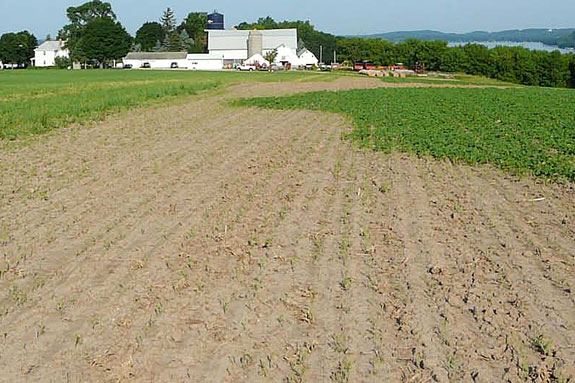Limited rainfall throughout the early season in some areas of the country stressed initial growth and has disappointed many with low first-cutting yields.
And as drought looms in some areas, it will be even more crucial to protect alfalfa from pests, one of the few variables over which growers have some control.
As summer temperatures rise, this may be the driving factor behind increased counts and documented damage from previously unseen pests in some areas.
Pests like variegated cutworm and potato leafhopper can significantly impact forage quality and overall yield. Here is some crucial background and tips on the management of these pests in alfalfa. 
Variegated cutworm
The variegated cutworm (Peridroma saucia) is a nocturnal “climbing cutworm” that climbs plant stems to feed, rather than cutting plants off at the soil surface, like black cutworm.
Typically growing up to two inches in length, variegated cutworm have a series of whitish-yellow spots along the middle of the back.
If populations meet or exceed two larvae per square foot in alfalfa, consider an application of a pyrethroid insecticide such as Warrior II with Zeon Technology or Besiege.
Potato leafhopper
Often considered a perennial pest of alfalfa, potato leafhopper (Empoasca fabae) can cause significant loss in forage and protein yields throughout the Midwest and eastern U.S.
The potato leafhopper (PLH) overwinters in the Gulf States of the U.S. and migrates northward with storm patterns in the spring. Potato leafhopper are extremely small (1/8 inch long), wedge-shaped, bright green in color and most active in temperatures of 53 to 93 degrees dry conditions.
With ideal conditions, 50 or 60 potato leafhoppers can produce from 500 to 1,000 offspring within a five-week period.
The insects pierce the alfalfa leaf vein and stop nutrients from flowing to the rest of the leaf causing a V-shape, or hopperburn, to develop. Subsequently, nutrient values are diminished and alfalfa yield is lowered.
Growers should use a sweep net to estimate PLH populations, which can then be used to help determine if treatment is warranted or if the alfalfa should be harvested.
To obtain PLH estimates, move a 15-inch sweep net vigorously through alfalfa in 180 degree arcs at several locations in each field. At least 25 sweeps should be taken from about four locations in each field.
The number of leafhoppers per sweep is obtained by counting the leafhoppers in the net and dividing by the number of sweeps (or arcs) taken in the field.
According to the University of Wisconsin, growers may consider treating alfalfa if PLH estimates reach the following levels. Note, if alfalfa is within seven days of a normal cutting, spraying is not recommended. It is then better to harvest as soon as possible.
• Alfalfa height: Less than 3 in.
PLH per sweep: 0.2
• Alfalfa height: 3 to 6 in.
PLH per sweep: 0.5
• Alfalfa height: 8 to 11 in.
PLH per sweep: 1.0
• Alfalfa height: 12 in. or taller
PLH per sweep: 2.0
Alfalfa growers should sample fields throughout the summer on a weekly schedule throughout the entire season. It is unwise to wait until the damage appears before making a decision to manage this insect.
Growers who suspect potato leafhoppers or variegated cutworm in their field should contact their local agronomist for additional information about how to manage and scout for these pests. FG
Brent Johnson
Alfalfa Brand Manager
NEXGROW
Mike Weiss
Agronomic Service Representative
Syngenta
—From Midwest Forage Association newsletter, Clippings – July 24, 2012
PHOTOS
TOP: A large mass of variegated cutworm in a Wisconsin soybean field.
BOTTOM: Variegated cutworm moving from alfalfa to soybeans. Photos by Brent Johnson.










